Impact of Climate Change: Environmental Assessment of Passive Solutions in a Single-Family Home in Southern Spain
Abstract
1. Introduction
2. Methods
2.1. Characterization for Regulatory Compliance and Energy Assessment under Current Climate Conditions
2.2. Energy Assessment under 2050 Climatic Conditions
2.3. Environmental Assesment of Passive Conditioning Solutions for Improvement under the 2050 Climatic Conditions
- ▪
- Envelope treatment solutions
- ▪
- Solar gain protection solutions
- ▪
- Ventilation solutions
3. Case study
3.1. Weather Data
3.2. Case Study Building Definition
3.3. Passive Conditioning Solutions
- ▪
- Envelope treatment solutions
- ○
- Façade Insulation (FI): the thickness of the façade thermal insulation layer of the base model is doubled, increasing from 6 to 12 cm.
- ○
- Roof Insulation (RI): the thickness of the roof thermal insulation layer of the base model is doubled, increasing from 6 to 12 cm.
- ○
- Uninsulated Floor (UF): the ground floor thermal insulation layer is removed in order to evaluate its heat dissipating capacity.
- ○
- Façade thermal Mass (FM): the thickness of the layer that provides the main thermal mass to the base model façade is doubled, increasing from 12 to 24 cm of perforated brick.
- ○
- Roof thermal Mass (RM): the thickness of the layer that provides the main thermal mass to the base model roof is doubled, increasing from 20 to 40 cm of concrete.
- ○
- Roof Pond (RP): a 30-cm-thick water pond has been included on the base model roof. As well as providing thermal mass, this solution favours the cooling process through evaporative loss, as the water temperature is 8–13 °C lower than the air temperature [26].
- ▪
- Solar gain protection solutions
- ○
- Solar Protection (SP): a solar screen is placed over the windows and it only allows the transmission of 5% of the solar energy to the indoors.
- ○
- Ventilated Façades (VF): a ventilated façade solution, with a ceramic finish and chamber openings in its base and top, is incorporated into the base model.
- ○
- Ventilated Roofs (VR): a ventilated roof solution, with a ceramic finish and chamber opening in its perimeter, is incorporated into the base model.
- ○
- Green Roofs (GR): a plant layer is included on the roof of the base model. Stomatal resistance is set at 50 s/m; reflectivity of the plant leaves at 0.22; absorptivity at 0.6; and humidity percentage at 12.5% [54]. With these characteristics, the roof only allows the transmission of 18% of the solar energy to the indoors.
- ○
- Envelope absorptivity (EA): a new exterior finish is applied to the base model envelope (façades and roof), with a white reflective paint base, and with absorptivity values decreasing from 0.7 in the base model (BM) to 0.05 in the EA model.
- ▪
- Ventilation solutions (NV)
4. Results and Discussion
4.1. Results in Current Climatic Conditions and the 2050 Climate Scenario
4.2. Energy Evaluation of Passive Conditioning Strategies in the 2050 Climate Scenario
5. Conclusions
Author Contributions
Funding
Conflicts of Interest
References
- IPCC. History of the IPCC. Available online: http://www.ipcc.ch/organization/organization_history.shtml (accessed on 15 August 2018).
- IPCC. Fifth Assessment Report on Climate Change. 2014. Available online: http://www.ipcc.ch/report/ar5/index.shtml (accessed on 15 February 2018).
- IPCC. Special Report on Emissions Scenarios (SRES). Nebojsa Nakicenovic and Rob Swart, Ed.; Cambridge University Press: UK, 2000. Available online: http://www.ipcc.ch/ipccreports/sres/emission/index.php?idp=0 (accessed on 15 February 2018).
- Directive 2012/27/EU of the European Parliament and of the Council. Available online: http://eur-lex.europa.eu/legal-content/EN/TXT/PDF/?uri=CELEX:32012L0027&from=EN (accessed on 15 May 2018).
- Communication from the Commission to the European Parliament, the Council, the European Economic and Social Committee and the Committee of the Regions. A Policy Framework for Climate and Energy in the Period from 2020 to 2030. Available online: http://eur-lex.europa.eu/legal-content/EN/TXT/?uri= COM%3A2014%3A15%3AFIN (accessed on 15 May 2018).
- Eurostat. Final Energy Consumption by Sector. 2015. Available online: http://ec.europa.eu/eurostat/statistics-explained/index.php/Consumption_of_energy#Consumption (accessed on 15 August 2018).
- Fuller, R.J.; Crawford, R.H. Impact of past and future residential housing development patterns on energy demand and related emissions. J. Hous. Built Environ. 2011, 26, 65–183. [Google Scholar] [CrossRef]
- Du, P.; Wood, A.; Stephens, B. Empirical Operational Energy Analysis of Downtown High-Rise vs. Suburban Low-Rise Lifestyles: A Chicago Case Study. Energies 2016, 9, 445. [Google Scholar] [CrossRef]
- Eurostat. Housing Statistics. Available online: http://ec.europa.eu/eurostat/statistics-explained/index.php?title=Housing_statistics#Type_of_dwelling (accessed on 7 August 2018).
- Santamouris, M.; Kolokotsa, D. On the impact of urban overheating and extreme climatic conditions on housing, energy, comfort and environmental quality of vulnerable population in Europe. Energy Build. 2015, 98, 125–133. [Google Scholar] [CrossRef]
- Coley, D.; Kershaw, T. Changes in internal temperatures within the built environment as a response to a changing climate. Build. Environ. 2010, 45, 89–93. [Google Scholar] [CrossRef]
- Indoor Air Pollution: New EU Research Reveals Higher Risks than Previously thought European Commission—IP/03/1278; EU Commission: Brussels, Belgium, 2003.
- Tzikopoulos, A.F.; Karatza, M.C.; Paravantis, J.A. Modeling energy efficiency of bioclimatic buildings. Energy Build. 2005, 37, 529–544. [Google Scholar] [CrossRef]
- Yau, Y.H.; Pean, H.L. The performance study of a split type air conditioning system in the tropics, as affected by weather. Energy Build. 2014, 72, 1–7. [Google Scholar] [CrossRef]
- The European Platform against Poverty and Social Exclusion: A European Framework for Social and Territorial cohesion. In Communication from the Commission to the European Parliament, the Council, the European Economic and Social Committee and the Committee of the Regions; European Commission: Brussels, Belgium, 2010.
- Ascione, F. Energy conservation and renewable technologies for buildings to face the impact of the climate change and minimize the use of cooling. Sol. Energy 2017, 154, 34–100. [Google Scholar] [CrossRef]
- Pacheco, R.; Ordóñez, J.; Martínez, G. Energy efficient design of building: A review. Renew. Sustain. Energy Rev. 2012, 16, 3559–3573. [Google Scholar] [CrossRef]
- Idris, Y.; Mae, M. Anti-insulation Mitigation by Altering the Envelope Layers’ Configuration. Energy Build. 2017, 141, 186–204. [Google Scholar] [CrossRef]
- León, A.L.; Suárez, R.; Bustamante, P.; Campano, M.A.; Moreno, D. Design and Performance of Test Cells as an Energy Evaluation Model of Facades in a Mediterranean Building Area. Energies 2017, 10, 1816. [Google Scholar] [CrossRef]
- Jaber, S.; Ajib, S. Optimum technical and energy efficiency design of residential building in Mediterranean region. Energy Build. 2011, 43, 1829–1834. [Google Scholar] [CrossRef]
- Al-Sanea, S.A.; Zedan, M.F. Effect of thermal bridges on transmission loads and thermal resistance of building walls under dynamic conditions. Appl. Energy 2012, 98, 584–593. [Google Scholar] [CrossRef]
- Wang, L.-S.; Ma, P.; Hu, E.; Giza-Sisson, D.; Mueller, G.; Guo, N. A study of building envelope and thermal mass requirements for achieving thermal autonomy in an office building. Energy Build. 2014, 78, 79–88. [Google Scholar] [CrossRef]
- Orosa, J.A.; Oliveira, A.C. A field study on building inertia and its effects on indoor thermal environment. Renew. Energ 2012, 37, 89–96. [Google Scholar] [CrossRef]
- Aste, N.; Angelotti, A.; Buzzetti, M. The influence of the external walls thermal inertia on the energy performance of well insulated buildings. Energy Build. 2009, 41, 1181–1187. [Google Scholar] [CrossRef]
- Sharifi, A.; Yamagata, Y. Roof ponds as passive heating and cooling systems: A systematic review. Appl. Energy 2015, 160, 336–357. [Google Scholar] [CrossRef]
- Spanaki, A.; Kolokotsa, D.; Tsoutsos, T.; Zacharopoulos, I. Assessing the passive cooling effect of the ventilated pond protected with a reflecting layer. Appl. Energy 2014, 123, 273–280. [Google Scholar] [CrossRef]
- Yadav, R.; Rao, D.P. Digital simulation of indoor temperatures of buildings with roof ponds. Sol. Energy 1983, 31, 205–215. [Google Scholar] [CrossRef]
- Spanaki, A.; Tsoutsos, T.; Kolokotsa, D. On the selection and design of the proper roof pond variant for passive cooling purposes. Renew. Sustain. Energy Rev. 2011, 15, 3523–3533. [Google Scholar] [CrossRef]
- Coma, J.; Pérez, G.; Solé, C.; Castell, A.; Cabeza, L.F. Thermal assessment of extensive green roofs as passive tool for energy savings in buildings. Renew. Energy 2016, 85, 1106–1115. [Google Scholar] [CrossRef]
- Niachou, A.; Papakonstantinou, K.; Santamouris, M.; Tsangrassoulis, A.; Mihalakakou, G. Analysis of the green roof thermal properties and investigation of its energy performance. Energy Build. 2001, 33, 719–729. [Google Scholar] [CrossRef]
- Goudarzi, H.; Mostafaeipour, A. Energy saving evaluation of passive systems for residential buildings in hot and dry regions. Renew. Sustain. Energy Rev. 2017, 68, 432–446. [Google Scholar] [CrossRef]
- Saadatian, O.; Sopian, K.; Salleh, E.; Lim, C.H.; Riffat, S.; Saadatian, E.; Toudeshki, A.; Sulaiman, M.Y. A review of energy aspects of green roofs. Renew. Sustain. Energy Rev. 2013, 23, 155–168. [Google Scholar] [CrossRef]
- Ascione, F.; Bianco, N.; de’ Rossi, F.; Turni, G.; Vanoli, G.P. Green roofs in European climates. Are effective solutions for the energy savings in air-conditioning? Appl. Energy 2013, 104, 845–859. [Google Scholar] [CrossRef]
- Zinzi, M.; Agnoli, S. Cool and green roofs. An energy and comfort comparison between passive cooling and mitigation urban heat island techniques for residential buildings in the Mediterranean region. Energy Build. 2012, 55, 66–76. [Google Scholar] [CrossRef]
- Kolokotsa, D.; Diakaki, C.; Papantoniou, S.; Vlissidis, A. Numerical and experimental analysis of cool roofs application on a laboratory building in Iraklion, Crete, Greece. Energy Build. 2011, 55, 85–93. [Google Scholar] [CrossRef]
- Synnefa, A.; Santamouris, M.; Livada, I. A study of the thermal performance of reflective coatings for the urban environment. Sol. Energy 2006, 80, 968–981. [Google Scholar] [CrossRef]
- Stevanović, S. Optimization of passive solar design strategies: A review. Renew. Sustain. Energy Rev. 2013, 25, 177–196. [Google Scholar] [CrossRef]
- León, A.L.; Domínguez, S.; Campano, M.A.; Ramírez-Balas, C. Reducing the Energy Demand of Multi-Dwelling Units in a Mediterranean Climate Using Solar Protection Elements. Energies 2012, 5, 3398–3424. [Google Scholar] [CrossRef]
- Seok, H.; Jo, J.; Kim, K. Establishing the design process of double-skin facade elements through design parameter analysis. J. Asian Archit. Build. Eng. 2009, 8, 251–258. [Google Scholar] [CrossRef]
- Ciampi, M.; Leccese, F.; Tuoni, G. Ventilated facades energy performance in summer cooling of buildings. Sol. Energy 2003, 75, 491–502. [Google Scholar] [CrossRef]
- Suárez, M.J.; Sanjuan, C.; Gutiérrez, A.J.; Pistono, J.; Blanco, E. Energy evaluation of an horizontal open joint ventilated façade. Appl. Therm. Eng. 2012, 37, 302–313. [Google Scholar] [CrossRef]
- Sanjuan, C.; Suárez, M.J.; González, M.; Pistono, J.; Blanco, E. Energy performance of an open-joint ventilated façade compared with a conventional sealed cavity façade. Sol. Energy 2011, 85, 1851–1863. [Google Scholar] [CrossRef]
- Peci López, F.; Jensen, R.L.; Heiselberg, P.; Ruiz de Adana Santiago, M. Experimental analysis and model validation of an opaque ventilated façade. Build. Environ. 2012, 56, 265–275. [Google Scholar] [CrossRef]
- Solgi, E.; Fayaz, R.; Kari, B.M. Cooling load reduction in office buildings of hot-arid climate, combining phase change materials and night purge ventilation. Renew. Energy 2016, 85, 725–731. [Google Scholar] [CrossRef]
- Santamouris, M.; Kolokotsa, D. Passive cooling dissipation techniques for buildings and other structures: The state of the art. Energy Build. 2013, 57, 74–94. [Google Scholar] [CrossRef]
- Campaniço, H.; Hollmuller, P.; Soares, P.M.M. Assessing energy savings in cooling demand of buildings using passive cooling systems based on ventilation. Appl. Energy 2014, 134, 426–438. [Google Scholar] [CrossRef]
- Lazzarin, R.M.; Noro, M. Energetic and economic savings of free cooling in different European climates. Int. J. Low-Carbon Technol. 2009, 4, 213–223. [Google Scholar] [CrossRef]
- Ministerio de Vivienda. Código Técnico de la Edificación (CTE) Documento Básico de Ahorro de Energía (DB-HE). 2017. Available online: https://www.codigotecnico.org/images/stories/pdf/ahorroEnergia/DcmHE.pdf (accessed on 15 May 2018).
- DesignBuilder. Available online: https://www.designbuilder.co.uk (accessed on 18 May 2018).
- University of Southampton. Climate Change World Weather File Generator for World-Wide Weather Data —CCWorldWeatherGen. Available online: http://www.energy.soton.ac.uk/ccworldweathergen/ (accessed on 15 November 2017).
- Jentsch, M.F.; James, P.A.B.; Bourikas, L.; Bahajb, A.S. Transforming existing weather data for worldwide locations to enable energy and building performance simulation under future climates. Renew. Energy 2011, 55, 514–524. [Google Scholar] [CrossRef]
- Reichler, T.; Kim, J. How Well Do Coupled Models Simulate Today’s Climate? Bull. Am. Meteorol. Soc. 2008, 89, 303–311. [Google Scholar] [CrossRef]
- Barbadilla-Martín, E.; Salmerón, J.M.; Guadix, J.; Aparicio-Ruiz, P.; Brotas, L. Field study on adaptive thermal comfort in mixed mode office buildings in southwestern area of Spain. Build. Environ. 2017, 123, 163–175. [Google Scholar] [CrossRef]
- Eumorfopoulou, E.; Aravantinos, D. The contribution of a planted roof to the thermal protection of buildings in Greece. Energy Build. 1998, 27, 29–36. [Google Scholar] [CrossRef]
- Peel, M.C.; Finlayson, B.L.; McMahon, T.A. Updated world map of the Köppen-Geiger climate classification. Hydrol. Earth Syst. Sci. 2007, 11, 1633–1644. [Google Scholar] [CrossRef]
- Weather Data Download—Cordoba 084100 (SWEC). Available online: https://energyplus.net/weather-location/europe_wmo_region_6/ESP//ESP_Cordoba.084100_SWEC (accessed on 15 November 2017).
- Instituto Eduardo Torroja de Ciencias de la Construcción. Catálogo de elementos Constructivos del CTE. 2010. Available online: https://www.codigotecnico.org/images/stories/pdf/aplicaciones/nCatalog_infoEConstr/CAT-EC-06.3_marzo_10.pdf (accessed on 5 Jun 2018).
- Ministerio de Vivienda. Código Técnico de la Edificación (CTE) Documento Básico de Salubridad (DB-S). 2017. Available online: https://www.codigotecnico.org/images/stories/pdf/salubridad/DcmHS.pdf (accessed on 15 May 2018).

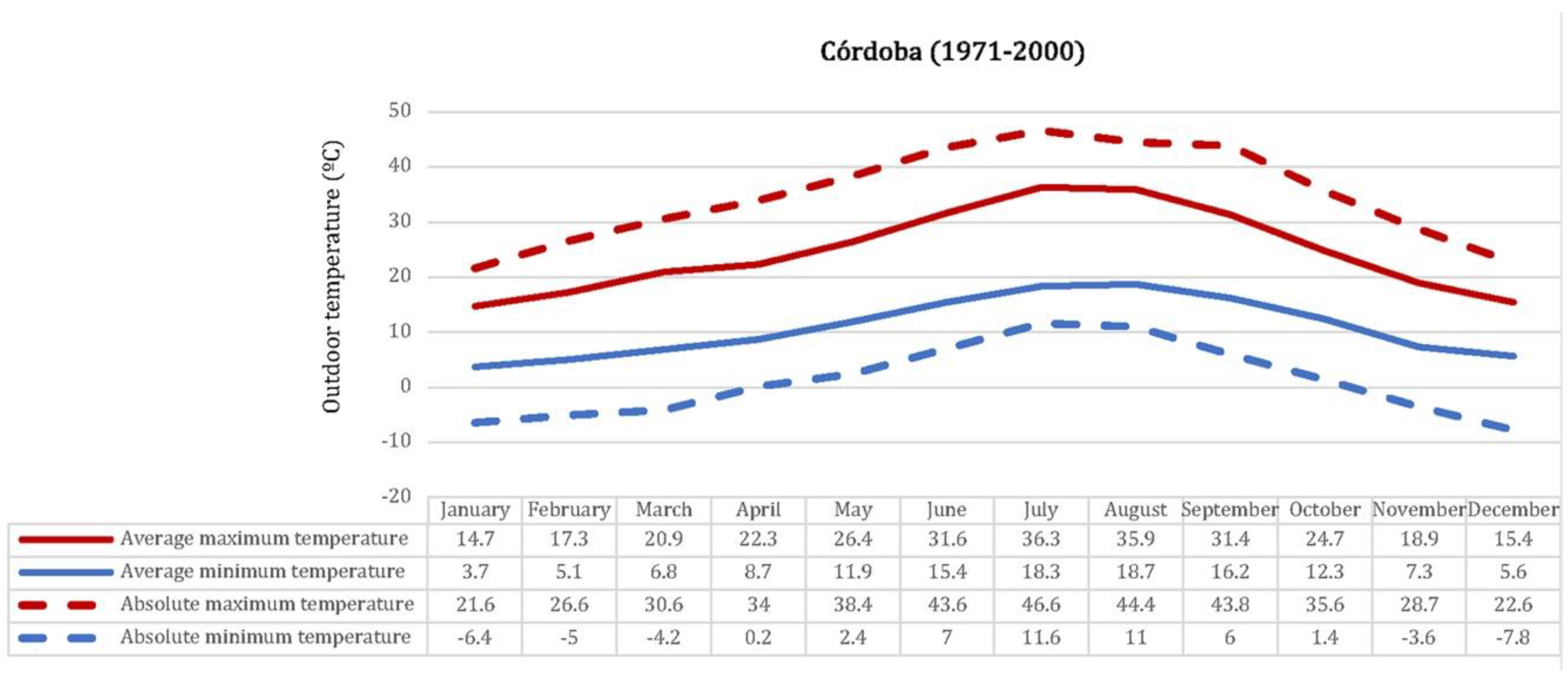
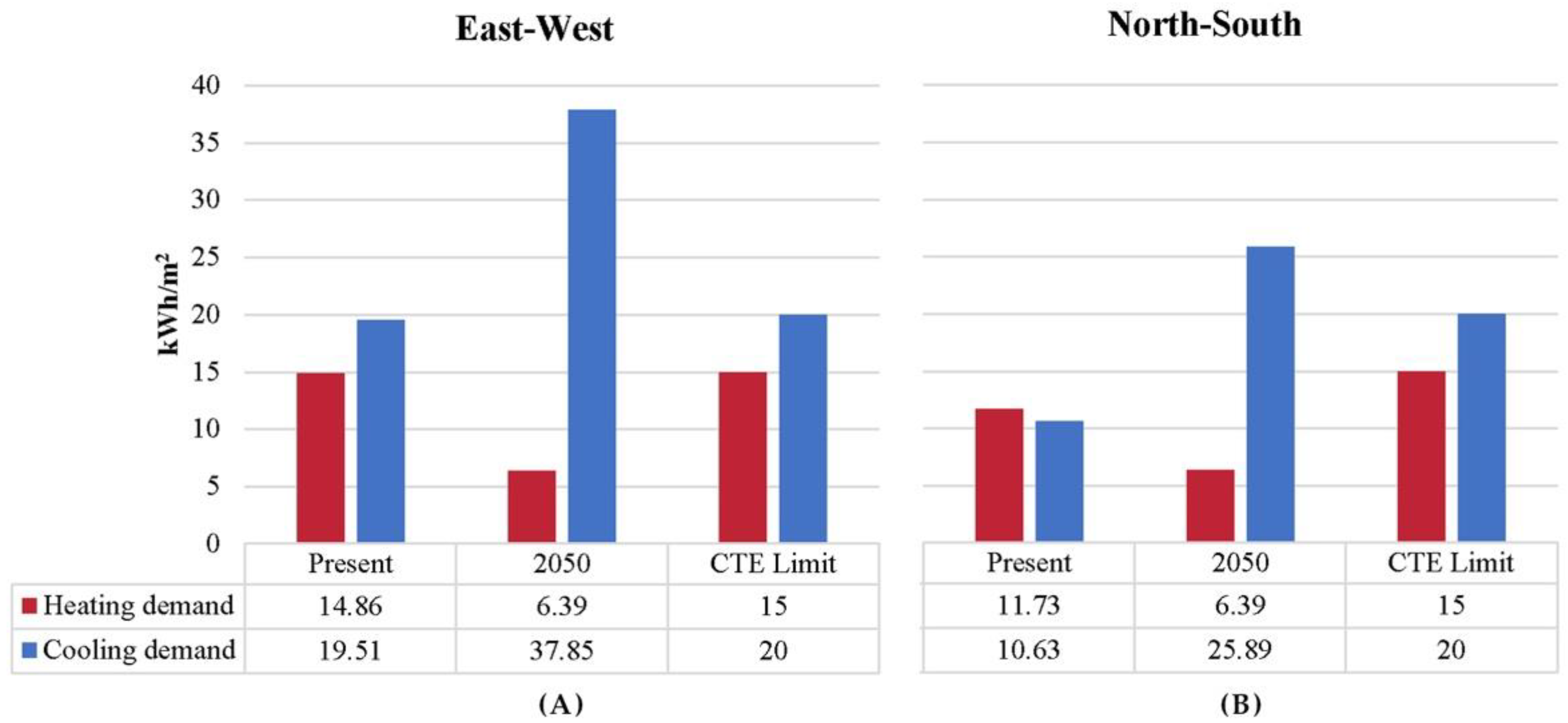
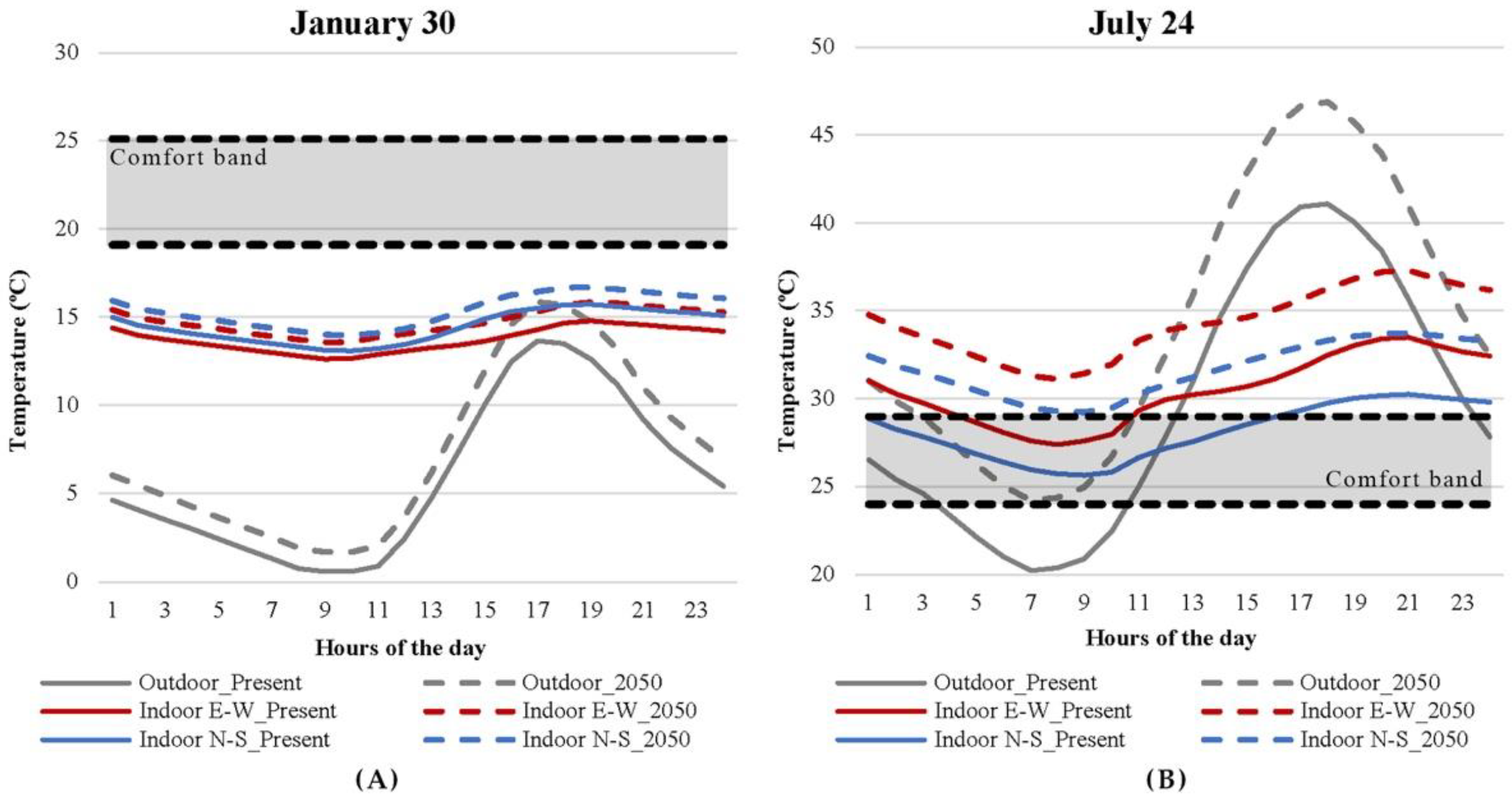
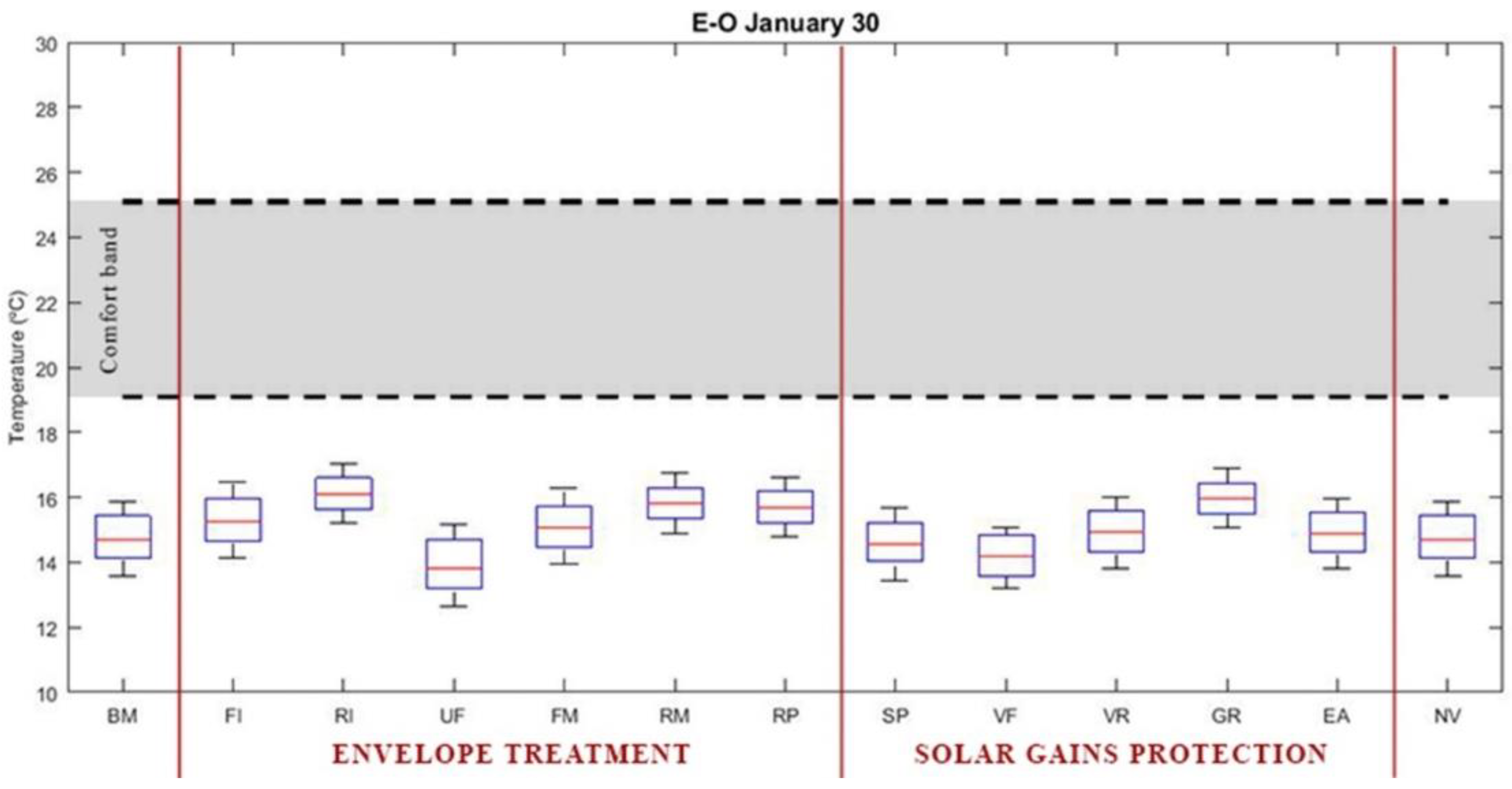
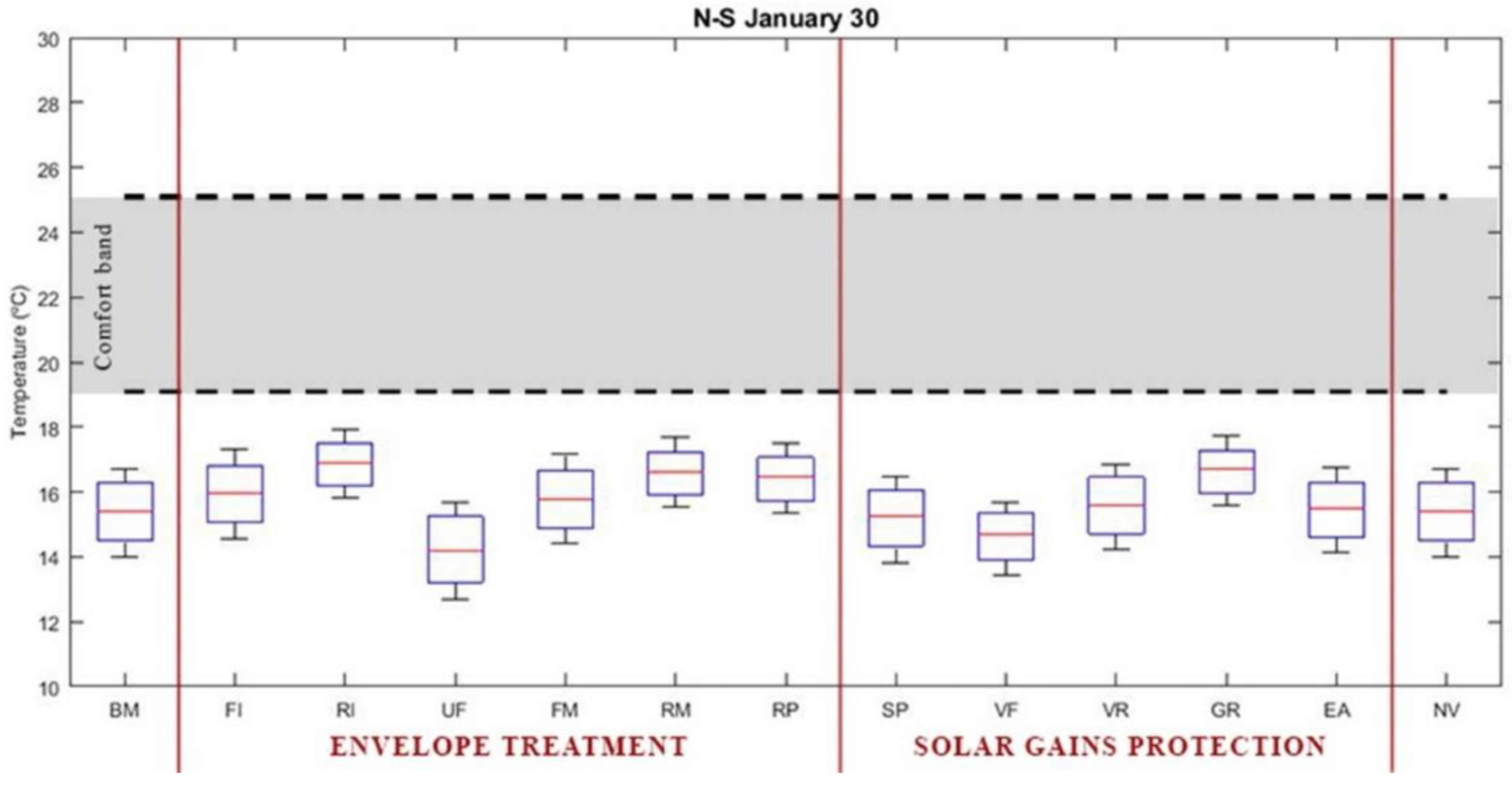
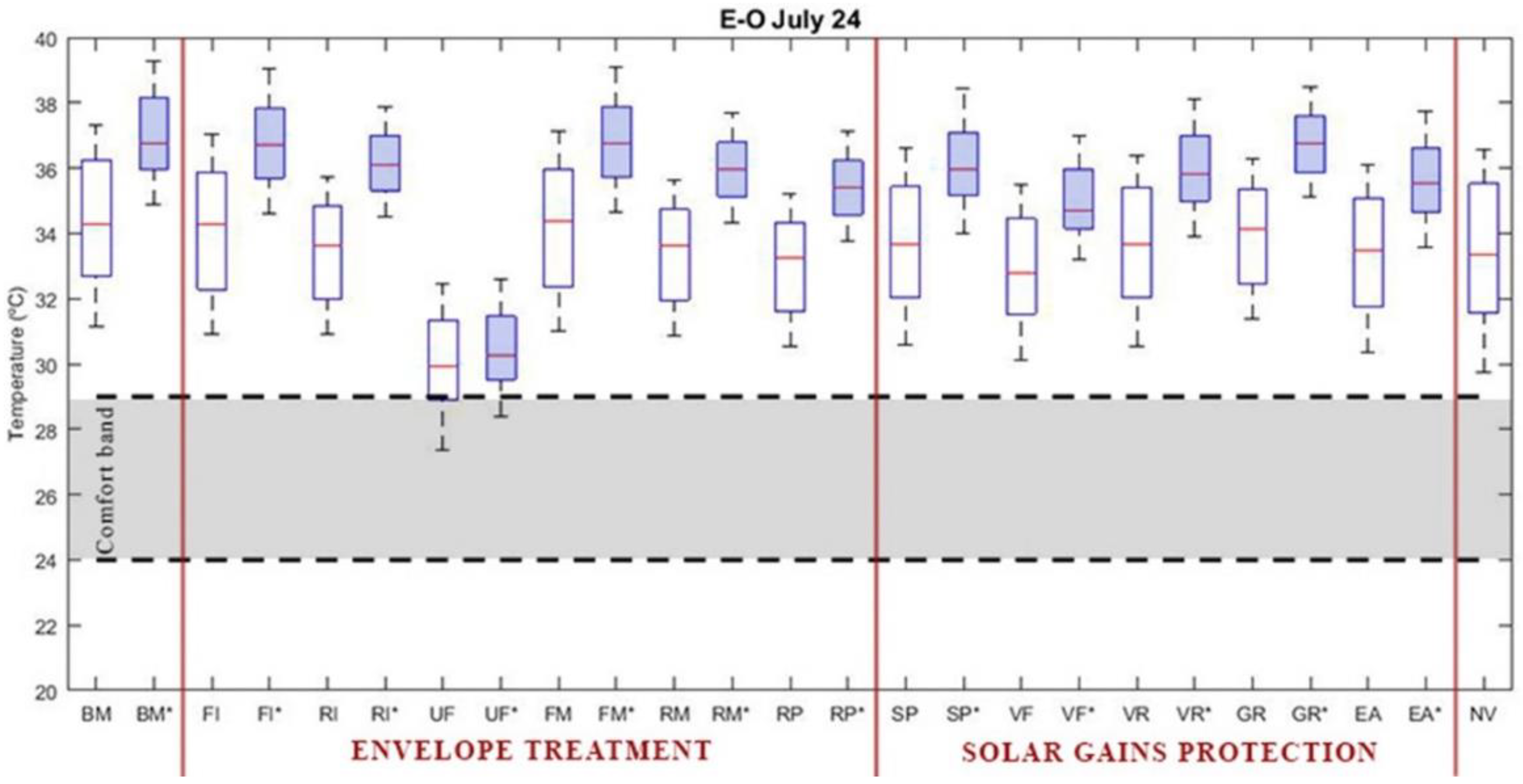
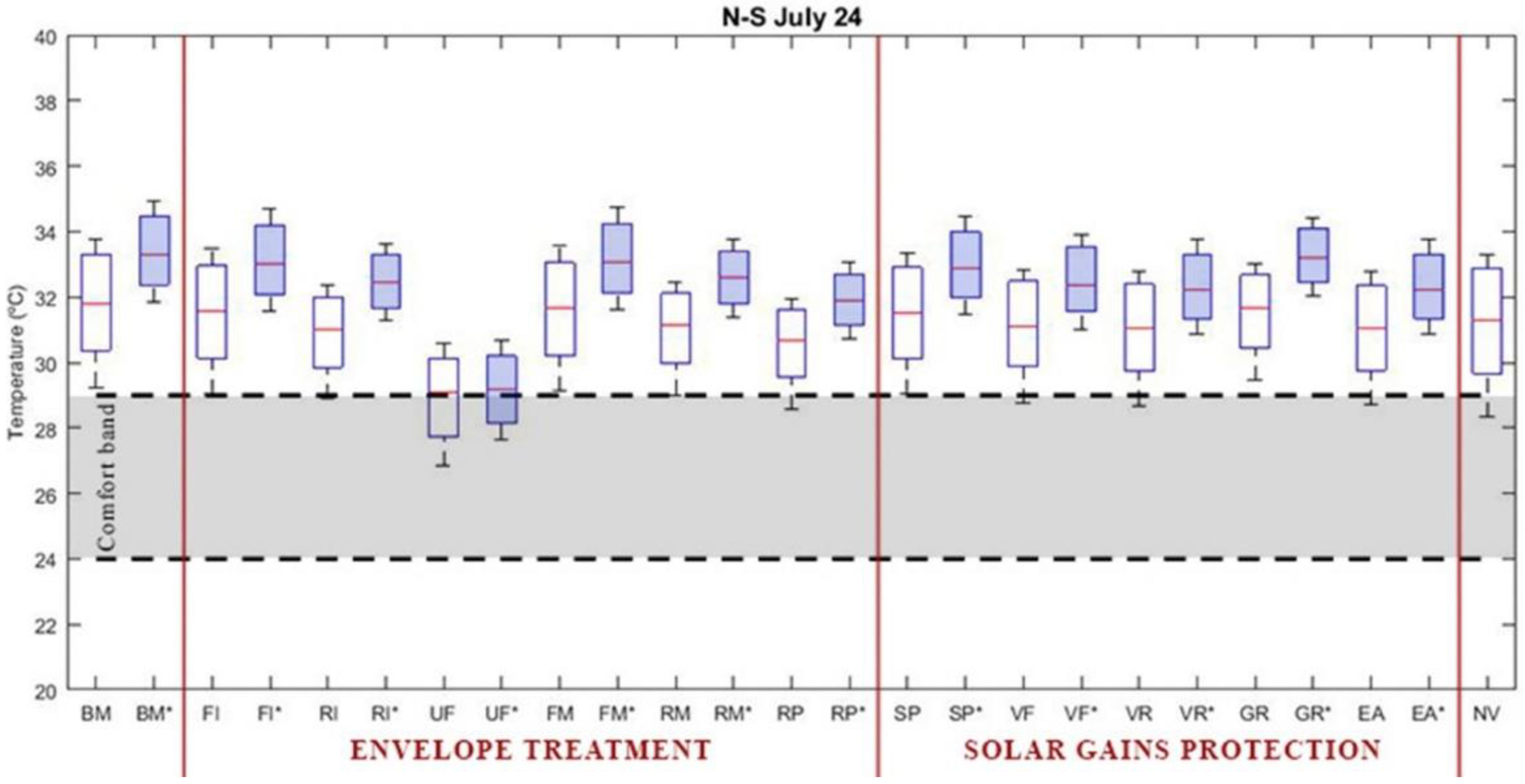
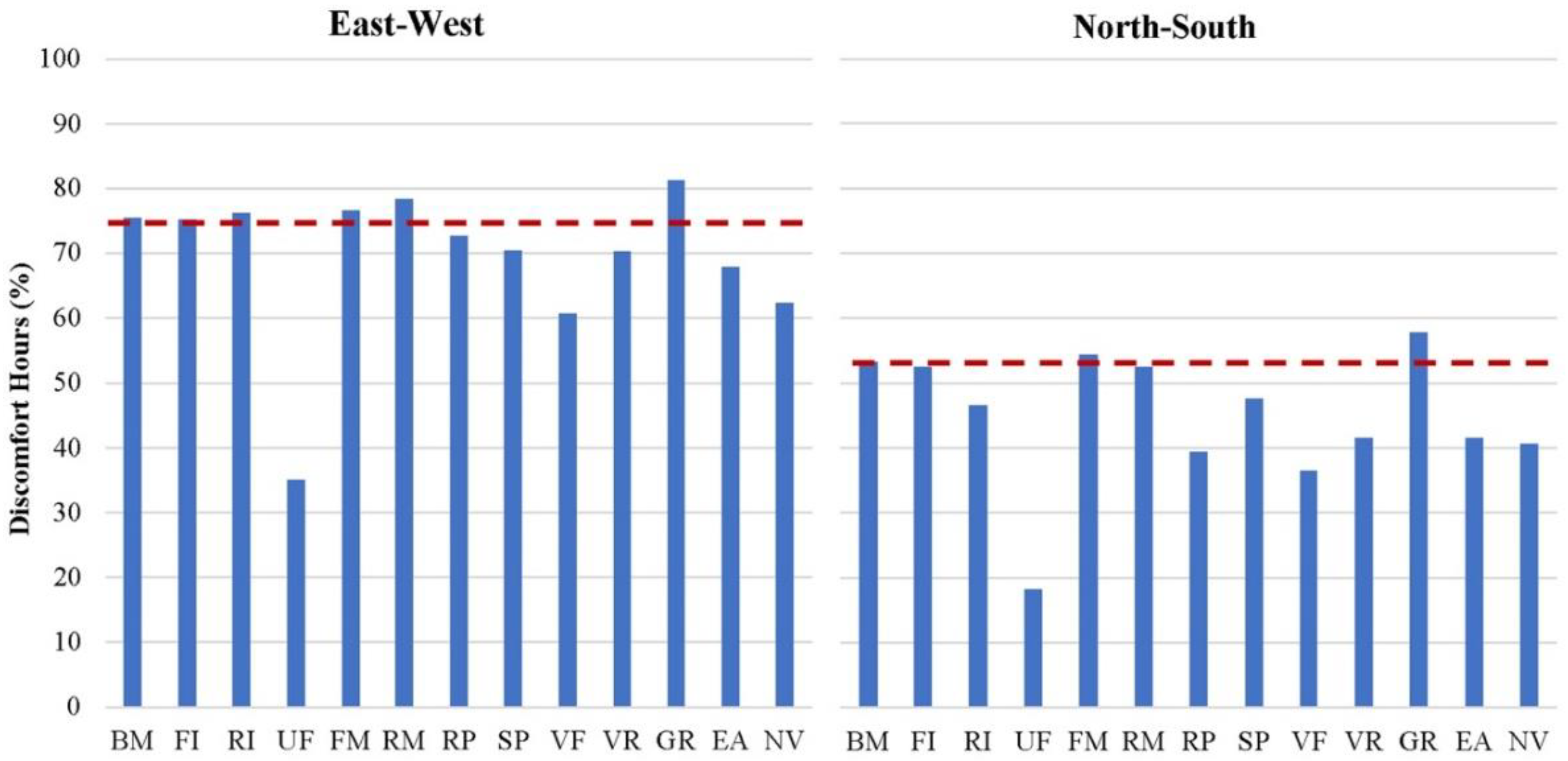
| Type | Layers (Outdoor → Indoor) | U (W/m2K) | Thermal Mass (kg/m2) | Indoor Thermal Capacity * (kJ/m2K) |
|---|---|---|---|---|
| FB Façade | Perforated brick (1/2 foot) + No ventilated air chamber (5 cm) + Polyurethane insulation (6 cm) + Double hollow brick (7 cm) | 0.30 | 195.4 | 56 |
| RB Roof | Concrete (20 cm) + Expanded polystyrene insulation (6 cm) | 0.47 | 490.0 | 0 |
| FB Floor | Expanded polystyrene insulation (5 cm) + Concrete (15 cm) | 0.64 | 367.5 | 245 |
| AB Window | Metal frame (with thermal break), 5/13/5 double-glazing. Solar transmission: 0.82. Surface: 10 m2 | 2.68 | − | − |
| Period | Presence | Set-Point Temperature | Natural Ventilation |
|---|---|---|---|
| Winter | Monday-Friday: 4 persons 24–8 h; 1 person 8–16 h; 2 persons 16–24 h. | 17 °C 24–8 h | 0.4 ACH 24 h |
| Weekend: 4 persons 24 h. | 20 °C 8–24 h | ||
| Summer | Monday-Friday: 4 persons 24–8 h; 1 person 8–16 h; 2 persons 16–24 h. | 27 °C 24–8 h | 4 ACH 23–9 h |
| No HVAC 8–15 h | |||
| Weekend: 4 persons 24 h. | 25 °C 15–24 h | 0.4 ACH 9–23 h |
| Type of Strategy | Layers (Outdoor → Indoor) | U (W/m2K) | Thermal Mass (kg/m2) | Indoor Thermal Capacity * (kJ/m2K) | |
|---|---|---|---|---|---|
| Envelope treatment | FI Façade | Polyurethane insulation (12 cm) + Perforated brick (1/2 foot) + No ventilated air chamber (5 cm) + Double hollow brick (7 cm) | 0.18 | 198.4 | 55 |
| RI Roof | Expanded polystyrene insulation (12 cm) + Concrete (20 cm) | 0.25 | 490.0 | 215 | |
| UF Floor | Concrete (15 cm) | 3.32 | 367.5 | 215 | |
| FM Façade | Polyurethane insulation (6 cm) + Perforated brick (1 foot) + No ventilated air chamber (5 cm) + Double hollow brick (7 cm) | 0.28 | 317.8 | 55 | |
| RM Roof | Expanded polystyrene insulation (6 cm) + Concrete (40 cm) | 0.44 | 980.0 | 215 | |
| RP Roof | Water (30 cm) + Expanded polystyrene insulation (6 cm) + Concrete (20 cm) | 0.38 | 790.0 | 215 | |
| Solar gain protection | VF Façade | Ceramic tile (2 cm) + Ventilated air chamber (5 cm) + Perforated brick (1/2 foot) + No ventilated air chamber (5 cm) + Polyurethane insulation (6 cm) + Double hollow brick (7 cm) | 0.30 | 195.4 | 55 |
| VR Roof | Ceramic tile (2 cm) + Ventilated air chamber (5 cm) + Concrete (20 cm) + Expanded polystyrene insulation (6 cm) | 0.47 | 490.0 | 0 | |
| GR Roof | Vegetation and sand (10 cm) + Expanded polystyrene insulation (6 cm) + Concrete (20 cm) | 0.40 | 560.0 | 215 | |
| Type of Strategy | East-West Summer Period (June–September) | ||||
|---|---|---|---|---|---|
| Maximum Temperature (°C) | Minimum Temperature (°C) | Discomfort Hours (%) | Average Deviation (°C) | ||
| Base model | 37.6 | 23.2 | 75.4 | 2.98 | |
| Envelope treatment | Façade Insulation | 37.4 | 23.5 | 75.1 | 2.94 |
| Roof Insulation | 36.2 | 24.4 | 76.2 | 2.62 | |
| Uninsulated Floor | 32.5 | 21.5 | 35.1 | 1.11 | |
| Façade thermal Mass | 37.6 | 23.7 | 76.7 | 3.03 | |
| Roof thermal Mass | 36.2 | 24.6 | 78.3 | 2.67 | |
| Roof Pond | 35.8 | 24.3 | 72.7 | 2.40 | |
| Solar gain protection | Solar Protection | 36.9 | 23.0 | 70.4 | 2.60 |
| Ventilated Façades | 35.8 | 22.8 | 60.6 | 2.14 | |
| Ventilated Roofs | 36.7 | 23.2 | 70.3 | 2.57 | |
| Green Roofs | 36.9 | 24.7 | 81.3 | 2.90 | |
| Envelope absorptivity | 36.4 | 23.1 | 67.9 | 2.45 | |
| Natural ventilation | 36.9 | 22.0 | 62.4 | 2.55 | |
| Type of Strategy | East-West Summer Period (June–September) | ||||
|---|---|---|---|---|---|
| Maximum Temperature (°C) | Minimum Temperature (°C) | Discomfort Hours (%) | Average Deviation (°C) | ||
| Base model | 34.0 | 22.8 | 53.3 | 1.61 | |
| Envelope treatment | Façade Insulation | 33.8 | 22.9 | 52.5 | 1.55 |
| Roof Insulation | 32.7 | 23.3 | 46.6 | 1.25 | |
| Uninsulated Floor | 30.6 | 20.9 | 18.2 | 0.48 | |
| Façade thermal Mass | 33.9 | 23.0 | 54.3 | 1.62 | |
| Roof thermal Mass | 32.9 | 23.7 | 52.5 | 1.33 | |
| Roof Pond | 32.3 | 23.2 | 39.3 | 1.20 | |
| Solar gain protection | Solar Protection | 33.5 | 22.6 | 47.6 | 1.45 |
| Ventilated Façades | 33.1 | 22.3 | 36.4 | 1.30 | |
| Ventilated Roofs | 33.0 | 22.3 | 41.6 | 1.29 | |
| Green Roofs | 33.4 | 23.8 | 57.8 | 1.54 | |
| Envelope absorptivity | 33.0 | 22.4 | 41.6 | 1.29 | |
| Natural ventilation | 33.5 | 21.4 | 40.7 | 1.44 | |
© 2018 by the authors. Licensee MDPI, Basel, Switzerland. This article is an open access article distributed under the terms and conditions of the Creative Commons Attribution (CC BY) license (http://creativecommons.org/licenses/by/4.0/).
Share and Cite
Suárez, R.; Escandón, R.; López-Pérez, R.; León-Rodríguez, Á.L.; Klein, T.; Silvester, S. Impact of Climate Change: Environmental Assessment of Passive Solutions in a Single-Family Home in Southern Spain. Sustainability 2018, 10, 2914. https://doi.org/10.3390/su10082914
Suárez R, Escandón R, López-Pérez R, León-Rodríguez ÁL, Klein T, Silvester S. Impact of Climate Change: Environmental Assessment of Passive Solutions in a Single-Family Home in Southern Spain. Sustainability. 2018; 10(8):2914. https://doi.org/10.3390/su10082914
Chicago/Turabian StyleSuárez, Rafael, Rocío Escandón, Ramón López-Pérez, Ángel Luis León-Rodríguez, Tillmann Klein, and Sacha Silvester. 2018. "Impact of Climate Change: Environmental Assessment of Passive Solutions in a Single-Family Home in Southern Spain" Sustainability 10, no. 8: 2914. https://doi.org/10.3390/su10082914
APA StyleSuárez, R., Escandón, R., López-Pérez, R., León-Rodríguez, Á. L., Klein, T., & Silvester, S. (2018). Impact of Climate Change: Environmental Assessment of Passive Solutions in a Single-Family Home in Southern Spain. Sustainability, 10(8), 2914. https://doi.org/10.3390/su10082914








